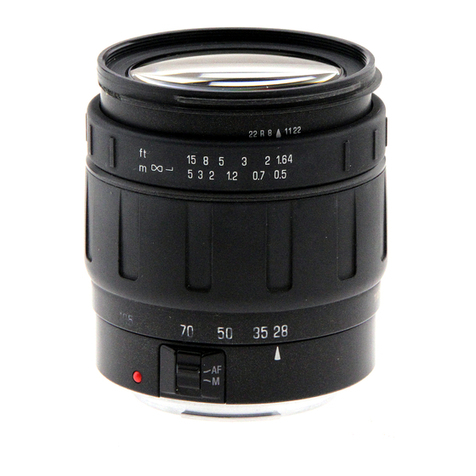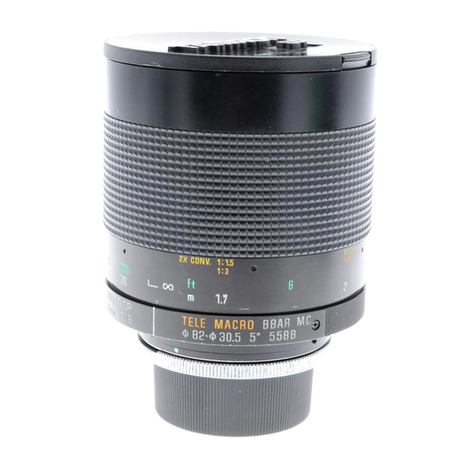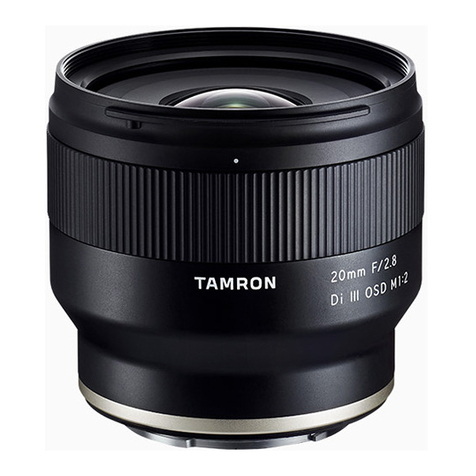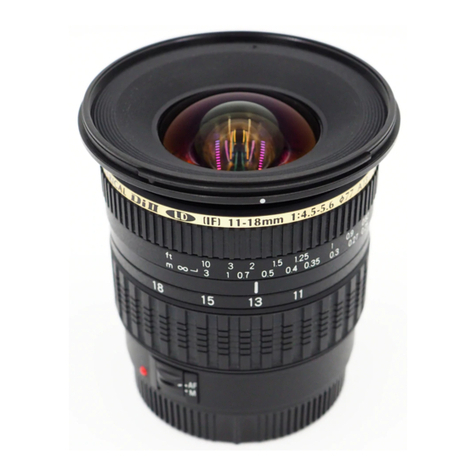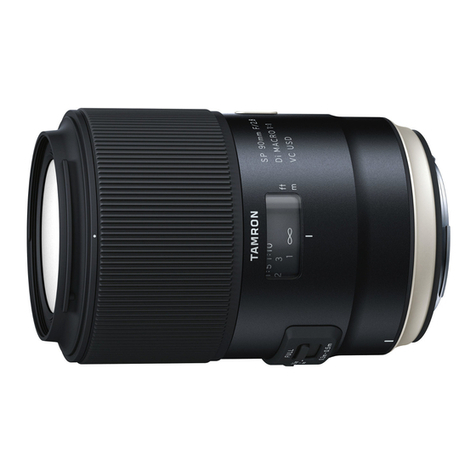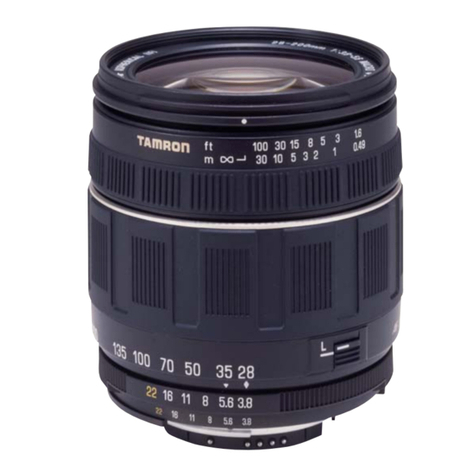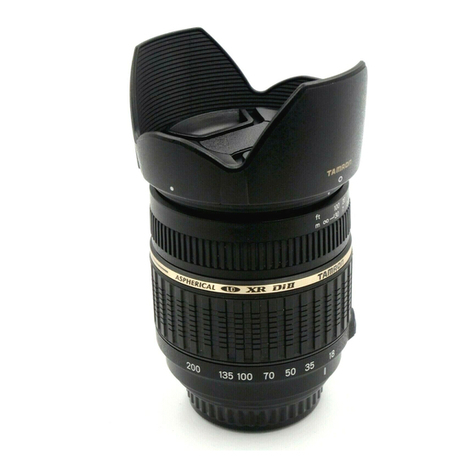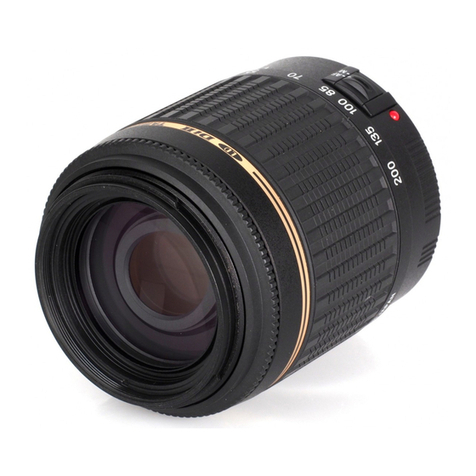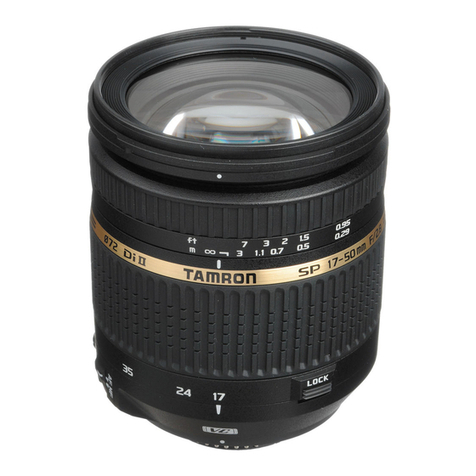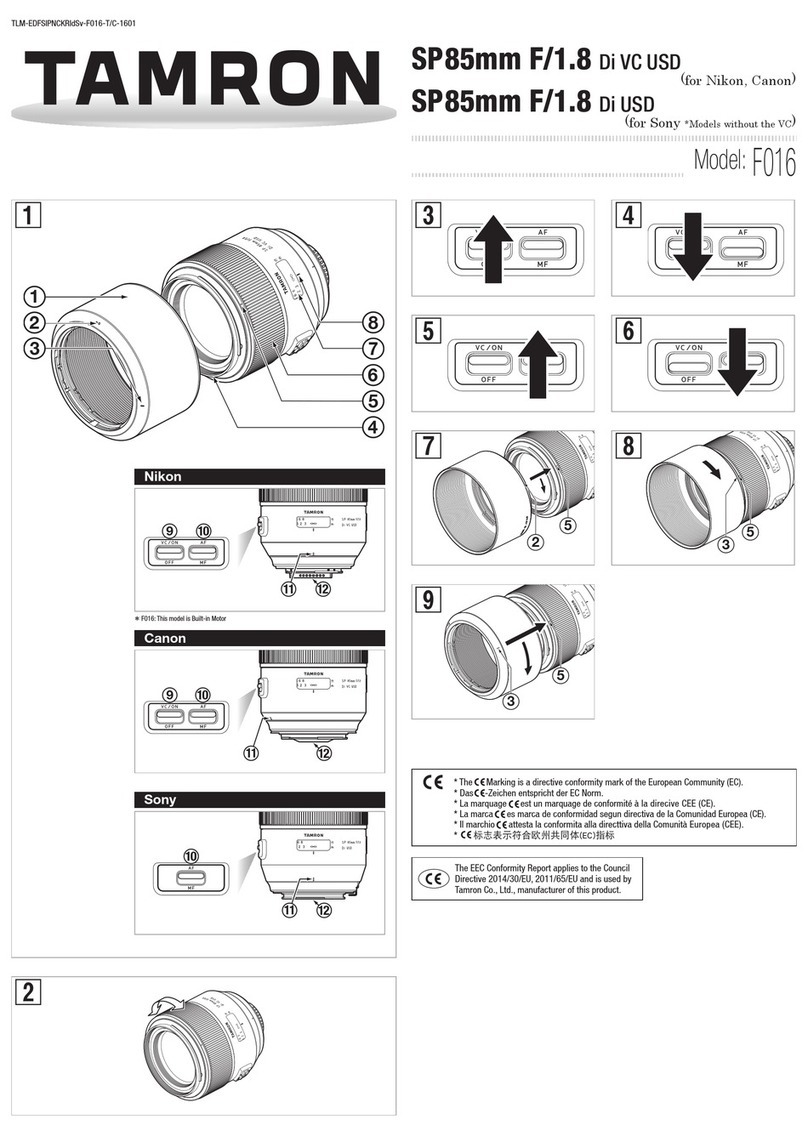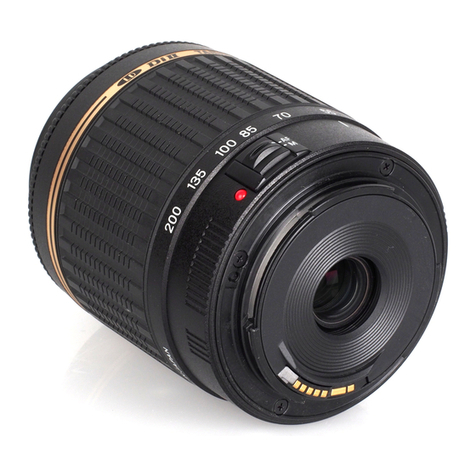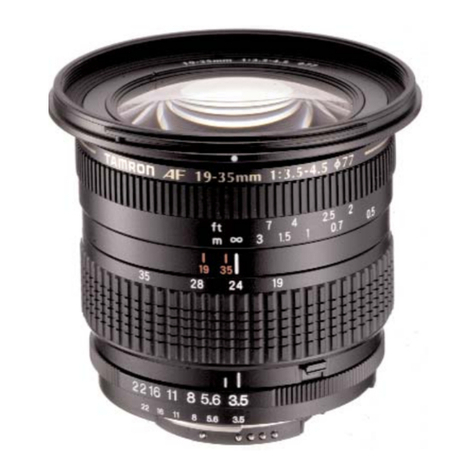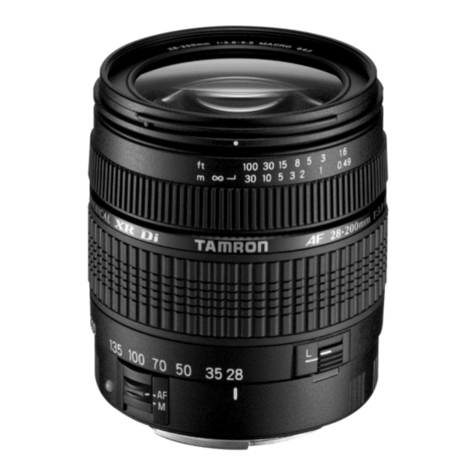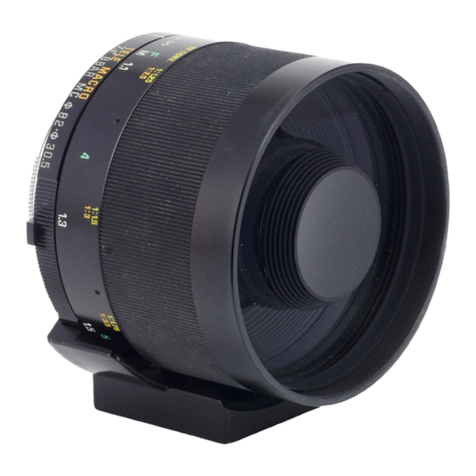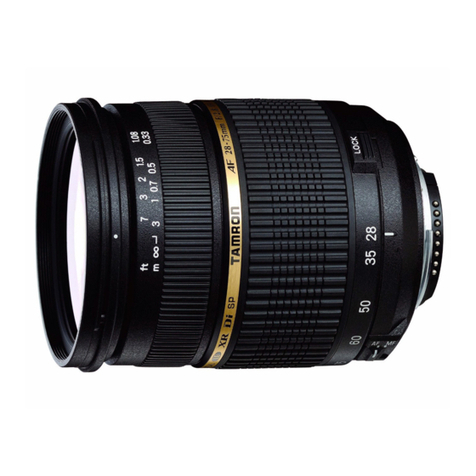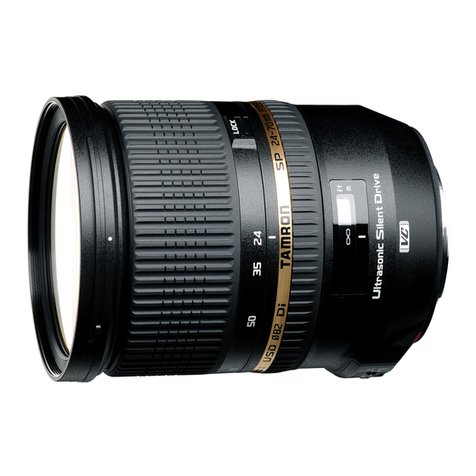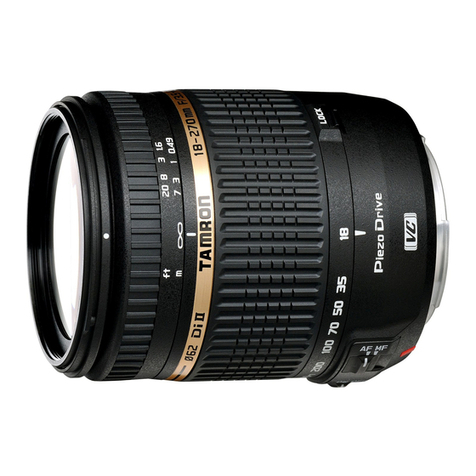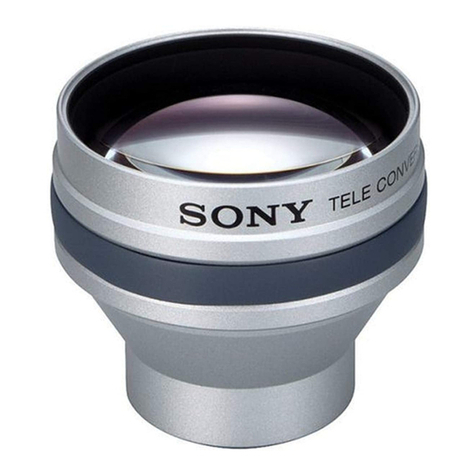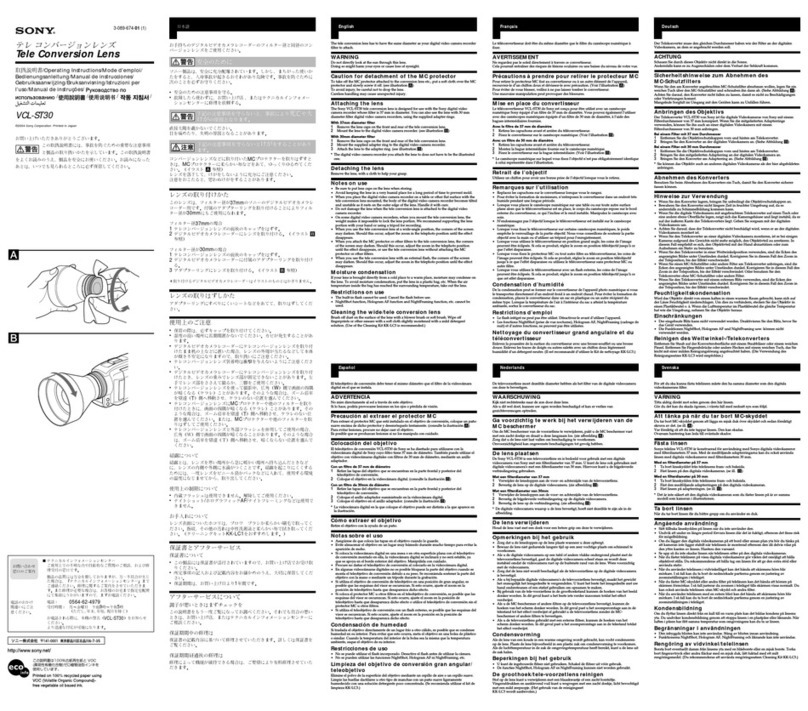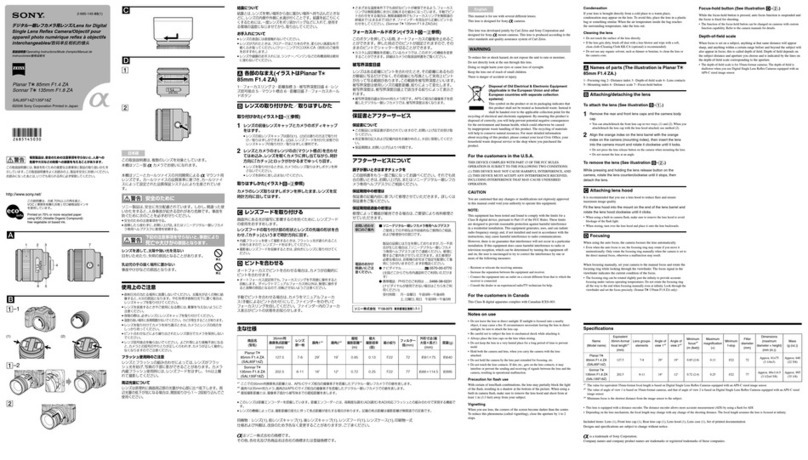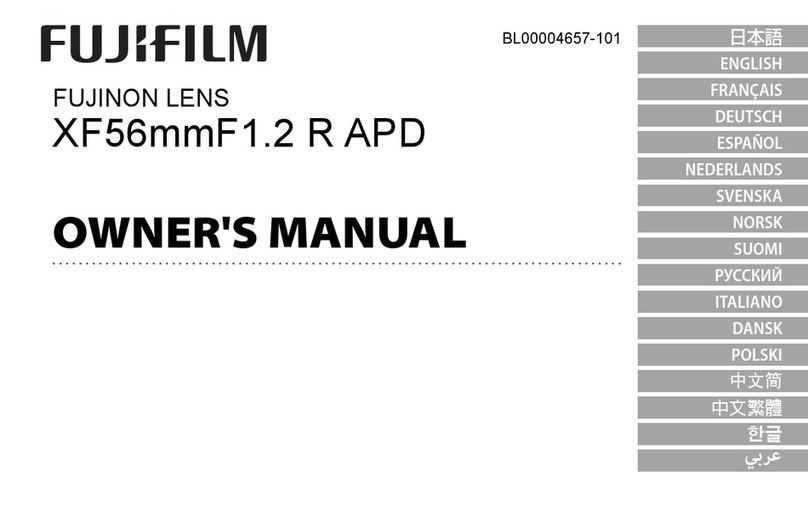
Thank you for purchasing the Tamron lens as the latest addition to your photographic
equipment. Before using your new lens, please read the contents of this Owner’s Manual
thoroughly to familiarize yourself with your lens and the proper techniques for creating
the highest quality images possible.With proper handling and care, your Tamron lens will
give you many years of photographing beautiful and exciting pictures.
폷Explains precautions that help to prevent problems.
폷Explains things you should know in addition to basic operations.
1Lens hood
2Hood attaching alignment mark
3Hood attaching indicator
4Filter ring
5Hood attaching index
6Focusing ring / AF·MF selector
7AF/MF selector index
8Distance index
9Distance scale
0Zooming ring
-Focal length scale
=Zoom index (also serves as lens attachment mark)
qTripod mount
wTripod mount index
eLocking screw
rVertical index
tHorizontal index
yLens attachment mark
uLens mount/Lens mount contacts
A001
Focal Length 70-200 mm
Maximum Aperture F/2.8
Angle of View 34°21'- 12°21'
Lens Construction (elements / groups) 13/18
Minimum Focusing Distance 0.95 m (Full zoom range) (3.1')
Maximum Magnification Ratio 1:3.1 (f=200mm, MFD=0.95m)
Filter Size ø77 mm
Length 194.3 mm쏄(7.6")
Diameter ø89.5 mm (3.5")
Weight (without tripod mount) 1,150 g쏄(40.6 oz)
Weight (tripod mount) 175 g (6.2 oz)
Lens Hood HA001
쏄
Length, diameter and weight listed in the lens specifications are for lenses with Nikon mounts.
폷Features and cosmetic designs of lenses listed in this owner’s manual may be revised
without notice.
쐽How to mount the lens
Remove the rear cap of the lens. Align the Lens attachment mark yon the lens barrel
with its counterpart on the camera mount and insert the lens.
Rotate the lens clockwise until it click-locks. For Nikon models, align the lens
attachment mark with the dot on the camera and rotate the lens counter-clockwise
until it click-locks.
쐽How to detach the lens
Pressing the lens release button on the camera down, turn the lens counter-clockwise
(in case of Nikon lens, clockwise), and lift the lens off the camera’s lens mount.
폷For further details, please read the instruction manual of your camera.
In case of Nikon and Canon cameras, push the focusing ring/AF·MF selector 6forward
to switch to AF mode. In case of Nikon camera with the focus mode selector dial, set
the focus mode to “S” or “C”, and then set the focusing ring / AF·MF selector 6to “AF.”
In case of Sony and Pentax cameras, set the camera to AF mode. Then push the
focusing ring/AF·MF selector 6forward to switch to AF mode. (Fig. 3) Press the
shutter button lightly while viewing through the camera’s viewfinder. The lens focuses
automatically. An in-focus mark will light when lens focuses on the main subject sharply.
Press the shutter button further to photograph.
폷When set on AF mode, interfering with focusing ring / AF·MF selector 6may cause
serious damage to the lens mechanism.
폷Make sure that you can see the letters “AF” 7on the focusing ring / AF·MF selector 6.
폷The distance scale 7is marked for guidance purposes. The actual focal point may
slightly differ from the distance marked on the focal length index.
폷For further details, please read the instruction manual of your camera.
In case of Nikon and Canon cameras, push the focusing ring/AF·MF selector 6
backward to switch to MF mode. In case of Nikon camera with the focus mode selector
dial, set the focus mode to “M”, and then set the focusing ring / AF·MF selector 6to
“MF.” In case of Sony and Pentax cameras, set the camera to MF mode. Then push the
focusing ring/AF·MF selector 6to backward to switch to MF mode. (Fig. 4) Focus
manually rotating the focusing ring / AF·MF selector 6while viewing through the
camera’s viewfinder. The main subject in the viewfinder will be sharp when the lens is
focused correctly.
폷Make sure the blue ring surrounding the focus ring is visible and the AF/MF selector
6covers the “M” mark 7.
폷
Even in the MF mode, when turning focusing ring / AF·MF selector 6while pressing the
shutter button halfway, the focus aid function lamp lights up when the picture is in focus.
폷At infinity, make sure the image in the viewfinder appears sharp. The infinity position is made with
certain allowances to insure proper focus under a variety of conditions.
폷For further details, please read the instruction manual of your camera.
Rotate zooming ring 0of the lens while viewing through the camera’s viewfinder and
compose your image at the chosen focal length.
Please follow the instruction manual of your camera.
A bayonet-type lens hood is provided as standard equipment. We recommend shooting with
the hood attached whenever possible as the lens hood eliminates stray light, which is
harmful to the picture. However, please be aware of the precautions stated in the next
section when your camera is equipped with a built-in flash.
쐽Attaching the Lens Hood (Ref. Figs. 5& 6)
Align Hood attaching alignment mark 2on the hood with the corresponding index mark
5on the lens. Press the hood lightly onto the hood attaching bayonet ring and then
rotate it clockwise to secure (Fig. 5). The lens hood will be secure when the mark
“TAMRON 쑗” is at the top (Fig. 6).
폷Improper attachment of a hood may cause large shadowed areas in your pictures.
쐽Stowing lens hood on the lens (Ref. Fig. 7)
1) Reverse the lens hood. Point the lens toward the opening, then align the hood
attaching index 5on the lens with the hood attaching indicator 3(TAMRON 쑗) on
the hood.
2) Turn the hood clockwise until the alignment mark (•) 2is at the top to set it. (Fig. 7)
A001 comes with a tripod mount. When using a tripod, mount the lens to it using the tripod
mount.
쐽
Changing the position of the camera horizontally and vertically. (Ref. Figs.
8)
1) Turn the locking screw eon the tripod mount counter-clockwise to loosen. (Step 1)
2) Line up the tripod mount index wwith the vertical index ror with the horizontal
index t. (Step 2)
3) Turn the locking screw eon the tripod mount clockwise to secure. (Step 1)
쐽Removing the tripod mount (Ref. Figs. 9)
1) Turn the locking screw eon the tripod mount counter-clockwise. (Step 1)
2) The tripod mount qwill loosen and can then be removed from the lens. (Step 3)
쐽Installing the tripod mount (Ref. Figs. 9)
1) Loosen the tripod mount qand attach it to the lens barrel. (Step 3)
2) Tighten the tripod mount qand turn the locking screw eclockwise to secure. (Step
1)
폷
When attaching or removing the tripod mount, be careful not to drop the camera and/or
the lens.
폷
Be cautious when carrying the lens while lens is attached to the tripod mount.
폷The optical design for Di takes into consideration the various features of digital single
reflex cameras. However, due to the configuration of the digital single reflex cameras, even
when the autofocus accuracy is within specifications, the focal point may be a little
forward or behind the optimum point when shooting with auto focus under some
conditions.
폷The lens employs an internal focusing (IF) system. Because of the characteristics of this
optical design, the angles of view at distances other than infinity are wider than that of the
lenses applying an ordinary focusing system.
폷
When the built-in flash on the camera is used, adverse photographic phenomena such as
corner illumination fall-off or vignetting at the bottom part of the image may be observed,
especially in wide angle ranges. This is due to the inherent limitation of the coverage of
the built-in flash, and/or the relative position of the flash to the edge of the lens barrel
which causes shadows on the image. It is strongly recommended to use a suitable
separate flash unit provided by the camera manufacturer for all flash photography.
For further details, please read the “built-in flash” article on the instruction manual of your camera.
폷When using the lens in the telephoto focal range, please be cauticus with the camera
shake. To avoid camera shake, for the digital cameras, use an ISO setting of higher
numbers and for the film cameras, use the film with high ISO numbers to obtain higher
shutter speed. Using a tripod or monopod is also effective.
When hand-holding the camera to take pictures, stand still opening your legs slightly a
part, hold your elbows in firmly against your chest, and hold the camera firmly against
your face. If possible, lean against something to steady yourself or place the camera on
something to secure the hold. Especially when hand-holding your camera, you will be
steadier if you hold your breath, while you press the shutter button gently and firmly.
폷When set on AF mode, interfering with focusing ring may cause serious damage to the
lens mechanism.
폷Certain camera models may indicate the maximum and minimum aperture values of the
lens in approximate numbers. This is inherent to the design of the camera and not an
indication of an error.
폷Please be aware that there is no infrared index line on any models listed in this owner’s
manual, and therefore, practically, no black-and- white infrared film can be used with
these lenses.
폷Avoid touching the glass element surface. Use a photographic lens cloth or blower to
remove dust from the lens element surface. When not using the lens, always place a lens
cap on it for protection.
폷
Use a lens cleaning tissue or lint cloth with a drop of cleaning solution to remove fingerprints
or dirt on the glass lens surface with a rotary motion from the center to the edge.
폷Use a silicon cloth to clean your lens barrel only.
폷Mildew is an enemy of your lens. Clean the lens after shooting near water or in any humid
place. Store your lens in a clean, cool and dry place.When storing the lens in an lens case,
store it with commercially available drying agent such as silicagel, and change the agent
occasionally. If you find mildew on your lens, consult an authorized repair shop or nearby
photographic store.
폷Do not touch the lens-camera interface contacts since dust, dirt and/or stains may cause a
contact failure between the lens and camera.
폷When using your equipment [camera(s) and lens(es)] in an environment where the
temperature changes from one extreme to the other, make sure to put your equipment
temporarily in a case or a plastic bag for a length of time in order for the equipment to go
through a gradual temperature shift. This will reduce potential equipment trouble.
ENGLISH
NOMENCLATURE (Refer to Fig. 1, if not specified)
SPECIFICATIONS
ATTACHING AND REMOVING THE LENS (Ref. Fig. 1)
FOCUSING (Autofocus) (Ref. Figs. 1, 2, 3)
ZOOMING (Ref. Fig. 1& 2)
PRECAUTIONS IN SHOOTING
TO ENSURE LONG-TERM SATISFACTION
LENS APERTURE AND AE MODE
LENS HOOD (Ref. Figs. 1, 5to 7)
TRIPOD MOUNT (Ref. Figs. 1, 8& 9)
FOCUSING (Manual Focus) (Ref. Figs. 1, 2, 4)
